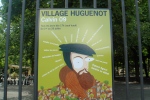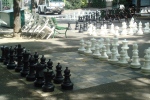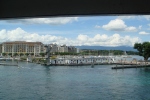The Calvin500 Anniversary Conference officially started their events this morning with five papers presented between 9:00am – 1:00pm. This morning was like what we will be seeing for the rest of the week: every morning there are addresses given by a number of well-known Calvin scholars from around the world. The speakers and their papers this morning (July 6th) included:
Dr. Douglas Kelly: “The Catholicity of the Theology of John Calvin”
Dr. Richard Gamble: “Recent Research in Calvin Studies”
Dr. Darryl Hart: “Calvin Among Nineteenth-Century Reformed Protestants in the United States”
Dr. Robert Kingdon: “Calvin and Ecclesiastical Discipline”
Dr. John Witte: “Reading Calvin as a Lawyer”
The papers presented throughout the week include a number of different studies on Calvin and about Calvinism. From dealing with “The Catholicity of the Theology of John Calvin,” all the way to “Calvin and his Children.”
The addresses this week are all given in the The Auditorie de Calvin. For those of you who do not know exactly what that is—it is where John Calvin taught his students during the Reformation. This particular building is one of the many that the Lord has used for His church and it has a very long history of Christian worship since the 15th century. The Auditorie de Calvin became a significant center for the development of the new Reformed thinking that was shaking the foundations of medieval Europe. Calvin would hold meetings in the building in 1557, as he and his other theologians would teach, take questions, and allow debates. It was also the church in which John Knox the Scotsman ministered in English between 1556—1559.
For a taste of what is going on, here is a small tidbit of Darryl Hart’s paper:
“Church life in the newly established United States presented an unusual set of circumstances for most Protestants. The disestablishment of religion that the Constitution’s First Amendment codified set most communions on a voluntaristic footing. Unlike previous arrangements where churches received subsidies from the state as part of the official apparatus of the nation, disestablishment in principle leveled all churches, made them dependent on their own followers for financial support, and freed each denomination to regulate its own affairs independent from the oversight of government. To be sure, at the state level ecclesiastical establishments remained in place after 1789, and those legal arrangements lasted the longest in New England thanks to the Standing Order among Congregationalists in Connecticut and Massachusetts. But despite the longevity of state churches in various places, the First Amendment signaled the future of church life; denominations would not receive state subsidies and in turn would be free to pursue their ministries as they deemed best.10
The new political context for the churches gave an advantage to denominations that were either independent of tax support or less particular about a learned ministry. Baptists and Methodists expanded dramatically during the first half of the nineteenth century while Episcopalians and Congregationalists lagged behind. Because Presbyterians had never enjoyed an establishment status in any of the American colonies or states, they had figured out ways to minister without the support their counterparts in places like Scotland possessed. Even so, demands for pastors who knew Greek and Hebrew, not to mention a prior training in the liberal arts, put Presbyterians at a disadvantage in American church life, perhaps not as great as that experienced by Episcopalians and Congregationalists, but sufficiently burdensome to prevent Presbyterians from competing with Baptists and Methodists as the most popular and rapidly growing Protestant denominations in the new nation.”11
For the evening sessions:
Ray Pennings writes:
“This evening, we had a time of worship in the cathedral that included three sermons. Dr. Philip Ryken preached on I Corinthians 16:5-11, “A Wide Door for Spreading the Gospel in which he highlighted (1) the constraints of the call; (2) the openness of the doors; and (3) the strength of the opposition. Dr. Peter Lilliback preached on I Corinthians 1:29-31, “All the Glorious Offices of Christ” in which he described how Christ as a Redeemer functions as prophet, priest and king. In the final message, Dr. Robert Godfrey expounded John 17:3 focusing on (1) the life that is eternal; (2) the God who is true; and (3) the Christ who God has sent.”
10 Mark A. Noll, A History of Christianity in the United States and Canada (Grand Rapids: Eerdmans, 1992), 143-53, provides a helpful overview of the new American environment for church life.
11 See Roger Finke and Rodney Stark, The Churching of America, 1776-2005: Winners and Losers in Our Religious Economy, 2nd ed., (New Brunswick, N.J.: Rutgers University Press, 2005), for a provocative study of Protestants in America’s religious free market.






















